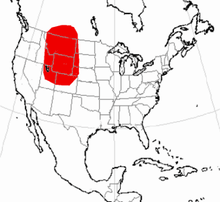Leptotragulus
| Leptotragulus Temporal range: Eocene | |
|---|---|
| Scientific classification | |
| Kingdom: | Animalia |
| Phylum: | Chordata |
| Clade: | Synapsida |
| Class: | Mammalia |
| Order: | Artiodactyla |
| Family: | †Protoceratidae |
| Genus: | †Leptotragulus Scott/Osborn (1887) |
| Species | |
| |
 | |
| Range of Leptotragulus based on fossil record | |
Leptotragulus is a small extinct genus of Artiodactyla, of the family Protoceratidae, endemic to North America from the Eocene epoch (Uintan to Chadronian stage) 40.2—33.9 Ma, existing for approximately 6.3 million years.[1]
Taxonomy
Leptotragulus was named by Scott and Osborn (1887). It was assigned to Leptotragulinae by Matthew (1908); to Hypertragulidae by Peterson (1919); and to Protoceratidae by Scott and Osborn (1887), Carroll (1988), Prothero (1998) and Prothero and Ludtke (2007).[2][3][4]
Morphology
Leptotragulus resembled deer. However they were more closely related to camelids. In addition to having horns in the more usual place, protoceratids had additional, rostral horns above the orbital cavity.
Body mass
Four fossil specimens of Prosynthetoceras were measured by M. Mendoza, C. M. Janis, and P. Palmqvist for body mass.[5]
- Specimen 1: 8.79 kg (19 lb)
- Specimen 2: 11.1 kg (24 lb)
- Specimen 3: 8.85 kg (20 lb)
- Specimen 3: 9.91 kg (22 lb)
Fossil distribution
Fossils have been recovered from:
- Goshen Hole Formation, Goshen County, Wyoming
- Wiggins Formation, Fremont County, Wyoming
References
- ↑ PaleoBiology Database: Leptotragulus, basic info
- ↑ W. D. Matthew. 1908. Osteology of Blastomeryx and phylogeny of the American Cervidae. Bulletin of the American Museum of Natural History 24(27):535-562
- ↑ O. A. Peterson. 1919. Annals of Carnegie Museum 12(2)
- ↑ R. L. Carroll. 1988. Vertebrate Paleontology and Evolution. W. H. Freeman and Company, New York 1-698
- ↑ M. Mendoza, C. M. Janis, and P. Palmqvist. 2006. Estimating the body mass of extinct ungulates: a study on the use of multiple regression. Journal of Zoology 270(1):90-101